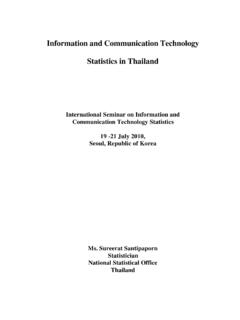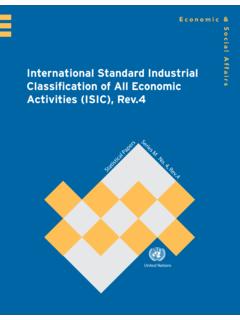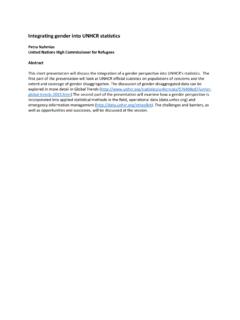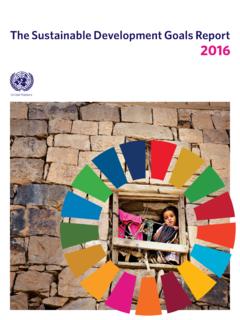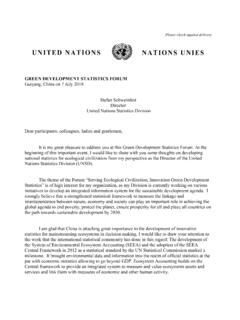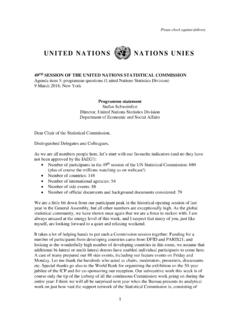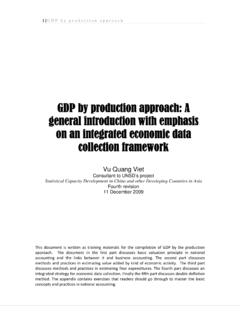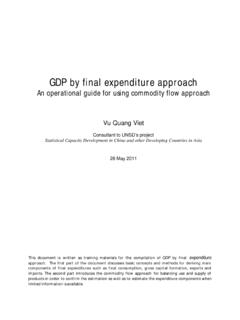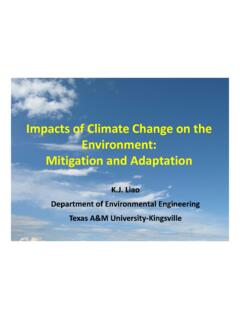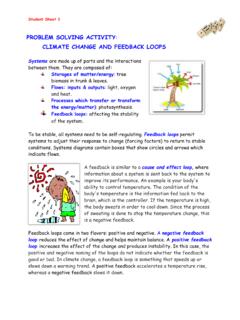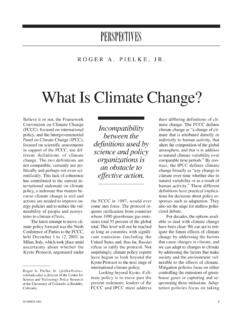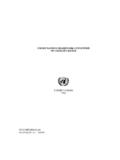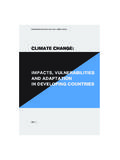Transcription of Section 5.3: Climate change - United Nations
1 Section : Climate change Excerpted from Chapter 5: Applications of the FDES to cross-cutting environmental issues, Framework for the Development of Environment Statistics (FDES 2013). February 2016. Prepared by United Nations Statistics Division Available at: Climate change 1 The conference of the Parties of the UNFCCC has affirmed that Climate change is one of the greatest challenges of our Climate change is a change of Climate which is attributed directly or indirectly to human activity that alters the composition of the global atmosphere and which is in addition to natural Climate variability observed over comparable time The world's Climate system, including the atmosphere, oceans and cryosphere, is changing and will continue to change at rates unprecedented in recent human history. Findings on the scientific basis for Climate change suggest that a number of human-induced alterations of the natural world are involved.
2 These alterations affect the global energy balance (the balance between incoming energy from the sun and outgoing heat from the earth) and ultimately lead to Climate change . 2 The Kyoto Protocol is an international agreement linked to the UNFCCC. Its main feature is that it sets binding targets for 37 industrialized countries and the European community to reduce GHG emissions, rather than simply encouraging them to attain these goals, as is the case with the Framework Convention. The targets amount to an average of five per cent against 1990 levels over the five-year period In 2012, the Doha Amendment (to the Kyoto Protocol) was adopted. This amendment further contributed to reducing GHG emissions by at least 18 percent below 1990 levels in the eight years from 2013 to 2020. It also expands the list of GHGs regulated by the Kyoto These conventions and protocols involve reporting obligations, which in turn create additional data requirements and demand for environment statistics.
3 3 The Rio+20 United Nations conference on Sustainable Development reaffirmed the pre- eminence of Climate change , expressing alarm about the rise of GHGs globally. In its outcome document, it called for cooperative action to coordinate effective international response to this challenge to ensure reduction of the emission of GHGs. It noted that countries already experience adverse impacts of Climate change such as persistent drought, extreme weather events, sea-level rise and threats to food security. In this regard, the conference indicated adaptation to Climate change to be an urgent global priority .5. 4 The IPCC has developed a sequence of events that describes the complexity of Climate change using a schematic framework (see Figure ). The cross-cutting application of the FDES is based on this framework. 1. United Nations Framework Convention on Climate change (2011). Report of the conference of the Parties on its sixteenth session, held in Cancun from 29 November to 10 December 2010.
4 Available from (accessed 30 July 2015). 2. United Nations Framework Convention on Climate change (1992). Available from (accessed 5 August 2015). 3. United Nations Framework Convention on Climate change (2014). Kyoto Protocol. Available from: (accessed 30 July 2015). 4. United Nations Framework Convention on Climate change (2014). Doha Amendment. Available from: (accessed 31 July 2015). 5. United Nations (2012). Rio+20 outcome document, The Future We Want . Available from (accessed 16 July 2015). Figure : Schematic framework representing anthropogenic drivers, impacts of and responses to Climate change , and their linkages6. 5 As seen, Climate change occurs through a chain of events and can be observable at all levels, from local to global. Climate process drivers are GHG emissions associated with current production and consumption patterns, which depend heavily on fossil fuels for energy and transportation.
5 These persistently high emissions lead to high atmospheric CO2 concentrations, which in turn prevent heat from escaping the Earth resulting in increased temperature and humidity, thus changing Climate patterns. The evidence of global warming and Climate change is unequivocal,7 including global temperature rise, extreme events, sea level rise, shrinking ice sheets and glacial Climate change evidence refers to the processes that substantiate the occurrence of changing Climate patterns at the global, regional and local levels. Climate change impacts include, among many others, more intense storms, changes in agricultural productivity, water scarcity and coral bleaching. Mitigation and adaptation processes are another important part of the sequence of Climate change . Mitigation aims to decrease sources of GHGs, while Climate change adaptation is an adjustment in natural or human systems in response to actual or expected climatic stimuli or their effects, which moderates harm or exploits beneficial 6.
6 Intergovernmental Panel on Climate change . Climate change 2007: Synthesis Report . Available from (accessed 31 July 2015). 7. Intergovernmental Panel on Climate change . Climate change 2007: Synthesis Report . Available from (accessed 31 July 2015). 8. Evidence of warming oceans, declining arctic sea ice (extent and thickness) and ocean acidification also exists. National Aeronautics and Space Administration. Global Climate change . Vital Signs of the Planet . Available from (accessed 31 July 2015). 9. United Nations Framework Convention on Climate change (2013). Glossary of Climate change Acronyms . Available from #A (accessed 31 July 2015). 6 Climate change mitigation refers to efforts to reduce or prevent greenhouse gas emissions and may involve using new technologies, incorporating and increasing renewable energies, making older equipment more energy efficient and changing management practices or consumer behaviour.
7 Efforts underway around the world range from building high-tech subway systems to installing bicycling paths and walkways. Protecting natural carbon sinks like forests and oceans, or creating new sinks through silviculture or green agriculture, are also elements of The development and deployment of renewable energy technologies and more efficient use of renewable energy sources will play a significant role in mitigation of GHG emissions, thereby presenting important opportunities to mitigate Climate change and contribute to sustainable development. Harnessing solar and wind energy, production of biofuels through new processes, enhanced geothermal systems and emerging ocean technologies are some areas of potential advancement in this regard. Current strategies to foster renewable energies, including direct regulation and the creation of economic instruments, must also be monitored.
8 7 Climate change impact and risks associated with Climate change are real and are already evident in many systems and sectors essential for human livelihood, including water resources, food security, coastal zones and health. Weather patterns have become more extreme, with more intense and longer events such as droughts, floods and increased precipitation over many land areas, as well as more hot days and heat waves. Associated risks include more frequent and dangerous floods and storms, greater stress on water supplies, decline in agricultural productivity and food security and further spread of water-related diseases, particularly in tropical areas. 8 The UNFCCC has identified Climate adaptation as a key building block for a coordinated response to Climate change . The IPCC describes adaptation as an adjustment in natural or human systems in response to actual or expected climatic stimuli or their effects, which moderates harm or exploits beneficial Adaptation does not take place in response to climatic changes in isolation, but instead is a response to a series of events or to previously existing situations that are exacerbated through Climate change .
9 As a consequence, it can be difficult to determine which aspects of adaptation are driven solely or partially by Climate change , as opposed to other factors not related to Climate change . This makes it difficult and challenging to measure adaptation to Climate change accurately. In addition, few comprehensive studies exist on what adaptation to Climate change entails, as well as the costs and benefits of adaptation measures. Nonetheless, adaptation is an important and necessary response to Climate change and statistics and methodologies to assess adaptation should be developed. 10. United Nations Environment Programme. Environment for Development - Climate change Mitigation. Available from (accessed 31 July 2015). 11. Intergovernmental Panel on Climate change , Fourth Assessment Report (2007). Climate change 2007: Impacts, Adaptation and Vulnerability , Cambridge University Press.
10 Available from (accessed 31 July 2015). Statistics on Climate change 9 A scientific approach to Climate change must be supported by well structured, relevant, reliable and timely statistics. Simultaneously, the need for underlying data to inform the policy aspects of Climate change remains a pressing requirement. Given their cross- cutting nature, Climate change statistics are relevant to a large proportion of the domain of environment statistics. 10 The UNECE is working actively with its member countries and other international organisations to develop Climate change -related These efforts primarily address data that are already collected by statistical offices and can support Climate change -related analysis or research. The work does not focus on scientific data ( , meteorological data) that measure changes in weather and Climate . The CES set up a Task Force on Climate change -Related Statistics in November 2011.
